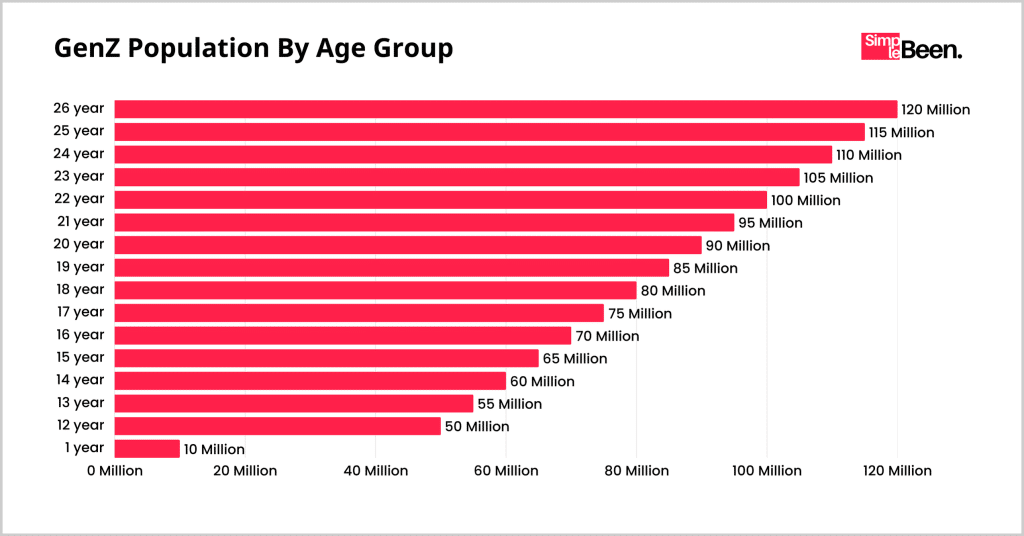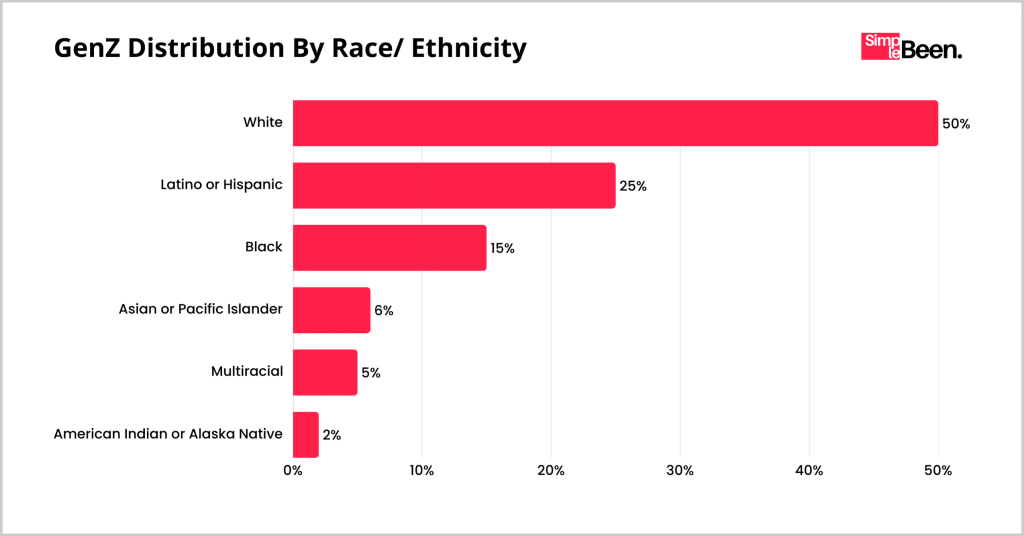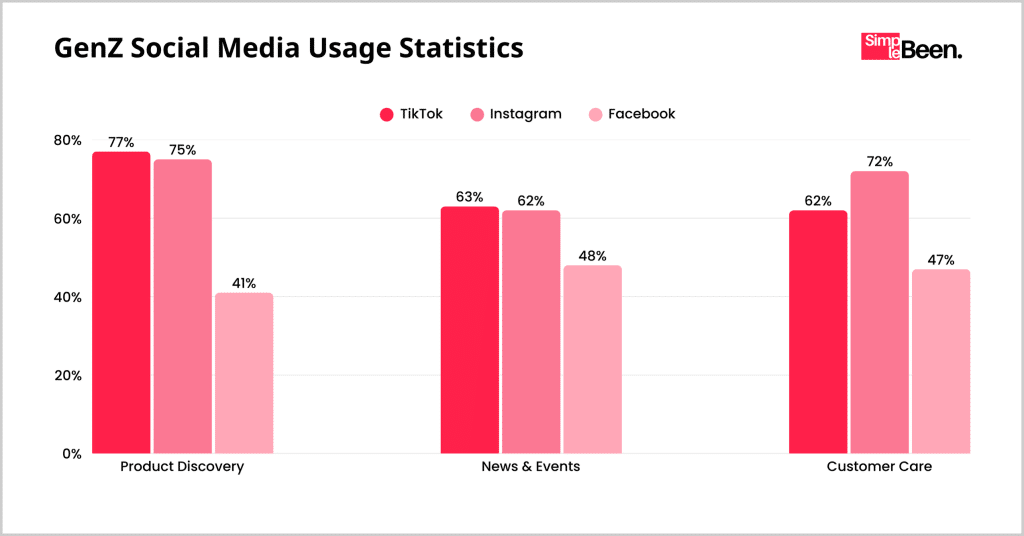Generation Z, born between 1997 and 2012, isn’t just growing up; they’re shaping the world around us. In 2025, they will make up 30% of the global population and nearly 27% of the workforce.
In the U.S. alone, almost 70 million Gen Zers are redefining work, education, tech, and culture. They’re digital natives; 95% of teens have a smartphone, and nearly half are online almost all the time.
But they also face real struggles: 65% have dealt with mental health issues recently, and many live paycheck to paycheck. This report explores who Gen Z is through their habits, values, challenges, and the future they’re creating.
Top GenZ Statistics For 2025
- As of 2025, Gen Z represents 27% of the workforce and currently makes up 30% of the global population, with 70 million Gen Z individuals in the U.S.
- 95% of Gen Z own smartphones, and 46% are online almost all the time, reflecting their deep connection to digital platforms.
- 50% of Gen Z identifies as white, and they are the most racially diverse generation in U.S. history, with significant Latino, Black, and Asian representation.
- 65% of Gen Z has dealt with mental health issues, and many lack access to treatment, particularly among minority groups.
- 46% of Gen Z live paycheck to paycheck, and they prefer hybrid or remote work, with 75% of them wanting such arrangements.
How Many Gen Z Are There Worldwide
Gen Z, the generation born between 1997 and 2012, makes up 30% of the world’s population right now.
By 2025, they’re expected to represent 27% of the global workforce. As they step into their careers, this generation will have an even bigger impact on the workplace, shaping trends and bringing fresh perspectives.

With their growing presence in both the population and the workforce, Gen Z is on track to play a key role in how industries and society evolve in the years ahead.
Source: Qureos
How Many GenZs Are There In The United States?
As of 2023, there are nearly 70 million Gen Z individuals living in the U.S.; that’s a big jump from about 57 million back in 2010.
According to data from the KIDS COUNT Data Center, Gen Z has grown steadily over the years, although millennials still outnumber them, with around 72.7 million in 2023, making millennials the largest generation that year.
State-wise, California has the highest number of Gen Zers (around 8.1 million), followed by Texas (about 6.9 million). On the flip side, Wyoming and Vermont have the fewest, with just over 123,000 and 126,000, respectively.
Source: The Annie E Casey Foundation
GenZ Demographics
With over 2 billion people worldwide, Gen Z is one of the largest and most diverse generations yet. From age, gender, and race to where they live, their demographics reveal how truly global and varied this generation is.
Gen Z Age Group
There are about 120 million 26-year-old GenZs, while only 50 million are aged 12.
Gen Z includes people born between 1997 and 2012, which means they’re around 12 to 27 years old today. When we look at the numbers, the older Gen Z crowd, especially those in their 20s, makes up a bigger part of the population.
What stands out is how the population drops for the younger ages. The numbers go down sharply from age 12 to age 1, just 10 million 1-year-olds compared to 50 million 12-year-olds. This shows that there have been fewer births in recent years.

Here is a table displaying the distribution of the Gen Z population by age group:
| Age | Population |
|---|---|
| 26 year | 120 Million |
| 25 year | 115 Million |
| 24 year | 110 Million |
| 23 year | 105 Million |
| 22 year | 100 Million |
| 21 year | 95 Million |
| 20 year | 90 Million |
| 19 year | 85 Million |
| 18 year | 80 Million |
| 17 year | 75 Million |
| 16 year | 70 Million |
| 15 year | 65 Million |
| 14 year | 60 Million |
| 13 year | 55 Million |
| 12 year | 50 Million |
| 1 year | 10 Million |
Source: market.us
GenZ Distribution By Race/ Ethnicity
Gen Z is the most racially and ethnically diverse generation in U.S. history so far. Unlike older generations, which were predominantly white, Gen Z reflects a broader mix of backgrounds and cultures.

As of 2023:
- About 50% of Gen Z identifies as white,
- 25% are Latino or Hispanic,
- 15% are Black,
- 6% are Asian or Pacific Islanders,
- 5% identify as multiracial, and
- Around 2% are American Indian or Alaska Native.
When we compare this to older generations, the difference becomes clearer:
- 54% of millennials are white,
- 59% of Gen X, and
- 71% of baby boomers fall into the same category.
Gen Z has also become more diverse over time. Between 2010 and 2023, the percentage of white Gen Zers dropped by three points, while the share of Latino and Asian/Pacific Islander Gen Zers each grew by about one percentage point.
Looking ahead, Gen Alpha — the generation following Gen Z — is expected to be even more diverse. In fact, less than half (48%) of Gen Alpha identify as white, indicating a continuing shift toward a more multicultural America.
Source: The Annie E Casey Foundation
Gen Z Education Statistics
Gen Z has grown up during a time of steady progress in education, with both their performance and access to schooling improving compared to earlier generations.
- When Gen Z reached 8th grade around 2011, math proficiency hit a peak, with 34% of 8th graders scoring at or above proficiency, up from just 25% in 2000. However, the pandemic caused a dip, and by 2022, only 26% of 8th graders were proficient in math.
- By the time Gen Z reached ages 16 to 19, only 4% had dropped out of school without a high school diploma, a significant improvement from 11% of millennials at the same age in 2000. This indicates that Gen Z is staying in school longer and more consistently.
- In 2022, the U.S. high school graduation rate for Gen Z reached a record high of 87%, marking the highest rate ever recorded. This increase was seen across all racial and ethnic groups, reflecting better access to education for all communities.
- Nearly half of Gen Z young adults (ages 18–24) are either attending college or have completed their degree, a notable increase from just 36% in 2000. This rate has remained steady for over a decade, showing a strong trend toward higher education.
- By 2012, only 17% of Gen Z were born to mothers without a high school diploma, down from 26% in 2006. This percentage continued to drop for the next generation, Gen Alpha, reaching just 11% in 2022, reflecting the increasing education levels across generations.
In short, Gen Z is growing up in a more educated, academically driven environment than previous generations, and this is shown in the data.
Source: The Annie E Casey Foundation
GenZ Employment Statistics
- Around 30% of Gen Z feels financially insecure, with 46% living paycheck to paycheck.
- 26% of working Gen Z worry they won’t be able to save enough for retirement.
- To cope with financial stress, 43% of Gen Z have taken on a second job.
- 40% of Gen Z plans to quit their current job within the next two years, a significantly higher percentage than the 24% of millennials.
- 35% of Gen Z would leave their job even if they don’t have another one lined up, indicating a more flexible approach to career choices.
- When choosing an employer, 32% of Gen Z prioritize work-life balance.
- 29% of Gen Z value opportunities for learning and growth, followed by 24% who prioritize a good salary, and 23% who want a positive workplace culture.
- Career growth opportunities are also important to 23% of Gen Z.
- 75% of working Gen Z pre-employees prefer hybrid or remote work arrangements.
- 63% of Gen Z prefer a hybrid model, while 12% would rather work remotely full-time for better work-life integration and mental well-being.
- 22% of Gen Z aim to be financially independent by the age of 30.
- 15% of Gen Z want to work in a career that truly resonates with them.
- 11% of Gen Z prioritize being surrounded by their loved ones.
Source: Deloitte, Whats The Big Data
GenZ Internet Usage Statistics
By 2024, having a smartphone had basically become second nature for Gen Z teens; a whopping 95% of those aged 13 to 17 had one, no matter their family’s income.
But when it comes to computers, the digital divide starts to show. While 93% of teens from families earning over $75,000 a year have a computer at home, only 78% of those from households earning under $30,000 enjoy the same access.
Being online is more than just a pastime for Gen Z; it’s a part of everyday life. Nearly half (46%) of teens say they’re online almost all the time, a big jump from just 24% back in 2014–15.
According to a 2023 Gallup survey, teens in this age group are spending about 5 hours a day on social media alone.
For Gen Z, constant connection isn’t something they do; it’s how they live. The internet is woven into their routines, relationships, and even their downtime.
Source: The Annie E Casey Foundation
Gen Z Social Media Usage Statistics
A significant 63% of Gen Z consumers rely on social media to discover new products, making these platforms a key part of their shopping habits.
According to the 2025 Sprout Social Index™, Gen Z is highly active on social media, with 89% using Instagram, 84% using YouTube, and 82% using TikTok, the top platforms for this generation. These platforms are not only entertainment hubs but also where Gen Z connects with friends and family.
When it comes to discovering products, TikTok leads the way as Gen Z’s go-to platform, followed closely by Instagram, according to the 2024 Social Media Content Strategy Report.
These platforms are also their primary sources for staying updated on the news, with TikTok and Instagram being top choices. Additionally, Instagram stands out for providing customer service, reflecting its role in fostering direct communication between brands and consumers.

| Category | TikTok | ||
|---|---|---|---|
| Product Discovery | 77% | 75% | 41% |
| News & Events | 63% | 62% | 48% |
| Customer Care | 62% | 72% | 47% |
In terms of engagement, Gen Z shows a clear preference for different content types across these platforms. For product discovery, TikTok leads with 77% of Gen Z users using it, closely followed by Instagram at 75%.
On Instagram and YouTube, Gen Z prefers engaging with videos or static images, with a strong interest in long-form videos on YouTube (over 60 seconds). Influencer-sponsored content also has a solid following, especially on YouTube, with 29% of Gen Z engaging with these types of posts.
The following table highlights Gen Z’s engagement levels across various content formats on YouTube and Instagram.
| Platform | Content Type | Engagement Percentage |
|---|---|---|
| YouTube | Long-form video (>60 seconds) | 50% |
| YouTube | Influencer sponsored content | 29% |
| YouTube | Short-form video (15-30 seconds) | 26% |
| Short-form video (<15 seconds) | 46% | |
| Static images | 40% | |
| Short-form video (15-30 seconds) | 36% |
Source: Social Sprout
Gen Z Statistics Mental Health
Gen Z is facing an unprecedented wave of mental health challenges. A 2023 survey found that 65% of Gen Zers had experienced a mental health issue in the past two years. That’s nearly two out of every three.
Let’s break it down:
- In 2016, 9% of U.S. kids (ages 3–17) had anxiety or depression. By 2020, that number hit 12%, equal to 7.3 million children.
- Among high schoolers, reports of persistent sadness or hopelessness jumped from 29% in 2011 to 42% in 2021, years that overlap with the high school experience of older Gen Z teens.
- In 2022, 1 in 3 Gen Z young adults (33%) felt persistently down, hopeless, or depressed, according to U.S. Census data.
Even when help is needed, many Gen Z youth don’t get it:
- A 2024 report revealed that 56% of Gen Z teens (ages 12–17) with major depression received no treatment.
- In 2022, only 49% of young adults (18–25) with any mental illness got the care they needed.
This gap is even wider for youth of color and LGBTQ+ individuals, who face higher risks of suicide and fewer pathways to support.
Source: The Annie E Casey Foundation
More Stats Like This:
What Is After Gen Z?
After Gen Z, those born roughly between 1997 and 2012, the next wave is Generation Alpha, made up of kids born between 2010 and 2024. They’re the first generation to grow up entirely in a world filled with smartphones, voice assistants, and streaming everything, tech is part of their everyday life from day one.
More than 2.8 million Generation Alpha children are born globally each week. By the time the youngest arrives in 2024, their total population is expected to reach nearly 2 billion, making them the largest generation the world has ever seen.
Although they’re still young, this generation is growing up fast in a digital-first world, and they’re already shaping how we learn, communicate, and connect.
Source: McCrindle










Leave a Comment